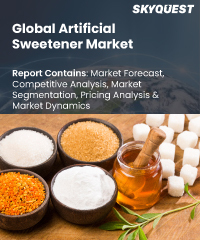
Report ID: SQMIG30C2096

Report ID:
SQMIG30C2096 |
Region:
Global |
Published Date: February, 2024
Pages:
261
|
Tables:
95 |
Figures:
76
Artificial Sweetener Market size was valued at USD 2.10 billion in 2021 and is poised to grow from USD 2.16 billion in 2022 to USD 2.74 billion by 2030, at a CAGR of 3% during the forecast period (2023-2030).
The global artificial sweetener market is a dynamic and rapidly expanding industry that caters to the growing demand for low-calorie and zero-calorie sweetening alternatives. With rising health consciousness and increasing concerns about obesity and diabetes, consumers are seeking healthier options to satisfy their sweet tooth. Artificial sweeteners serve as a viable solution by providing the desired sweetness without the added calories of traditional sugar. The purpose of the market is to offer a wide range of artificial sweetening substances that can be used in various food and beverage products, such as soft drinks, baked goods, confectionery, dairy products, and more. These sweeteners not only provide a sweet taste but also contribute to maintaining a healthier lifestyle. Several drivers fuel the growth of the global artificial sweetener market. Firstly, the rising prevalence of health conditions like diabetes and obesity drives the demand for sugar substitutes. Additionally, the growing preference for low-calorie and healthier food options among consumers further propels market growth. Moreover, the increasing awareness of the adverse effects of excessive sugar consumption on overall health and wellness acts as a catalyst for market expansion.
However, the market does face some restraints. One of the challenges is the perception of artificial sweeteners having an aftertaste or not replicating the exact taste of sugar. Consumer preferences and taste sensitivities can influence the adoption of these sweeteners. Additionally, stringent regulatory frameworks and safety concerns regarding the long-term effects of artificial sweeteners pose hurdles for market players. Key trends in the market include the development of innovative and natural-based sweeteners to meet the demand for healthier and more natural alternatives. Manufacturers are also focusing on enhancing the taste profiles of artificial sweeteners to provide a more satisfying experience for consumers. Amidst these challenges and trends, the global market offers numerous opportunities. The market presents a vast potential for expansion as consumers increasingly adopt healthier eating habits and seek alternatives to traditional sugar. Developing economies, with their growing population and rising disposable income, represent untapped markets for artificial sweetener products. Furthermore, the rise of e-commerce and online retail channels provides convenient avenues for market players to reach a wider consumer base.
US Artificial Sweetener Market is poised to grow at a sustainable CAGR for the next forecast year.
Our industry expert will work with you to provide you with customized data in a short amount of time.
REQUEST FREE CUSTOMIZATIONWant to customize this report? This report can be personalized according to your needs. Our analysts and industry experts will work directly with you to understand your requirements and provide you with customized data in a short amount of time. We offer $1000 worth of FREE customization at the time of purchase.

Report ID: SQMIG30C2096